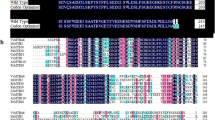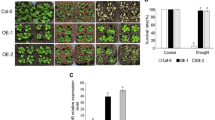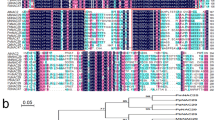Abstract
Anthurium andraeanum Lind. is an important ornamental flower in which accumulation of photosynthetic pigments affects both growth status and ornamental quality. ARABIDOPSIS PSEUDO RESPONSE REGULATOR2 (APRR2) transcription factor, encoded by APRR2-like gene, is reported to influence the accumulation of photosynthetic pigments in tomato and cucumber. Although several studies have shown a link between photosynthetic pigment accumulation and stress tolerance, the possible role of APRR2-like genes in abiotic stress responses has been unclear. In this study, an APRR2 ortholog, AaAPRR2, was isolated from leaves of ‘dark green’ mutant in A. andraeanum ‘Sonate’. qRT-PCR showed that AaAPRR2 had higher transcript levels in spathe, root and strong leaf than in other tissues. The analysis of conserved structural domains in the 4 predicted APRR2-like protein sequence showed that AaAPRR2 contains conserved REC superfamily and MYB-like DNA domain. Heterologous overexpression of AaAPRR2 in Arabidopsis increased photosynthetic pigment accumulation and the transcript levels of endogenous genes related to photosynthetic pigment synthesis. Salinity stress analysis of 35S::AaAPRR2 and WT lines suggested that AaAPRR2 improved salt stress tolerance in Arabidopsis. These results demonstrate a link between photosynthetic pigment contents and abiotic stress and may be useful for enhancing plant color and improving ornamental value.





Similar content being viewed by others
References
Bailey TL, Elkan C (1994) Fitting a mixture model by expectation maximization to discover motifs in biopolymers. Proc Int Conf Intell Syst Mol Biol 2:28–36
Clough SJ, Bent AF (1998) Floral dip: a simplified method for Agrobacterium-mediated transformation of Arabidopsis thaliana. Plant J 16:735–743
Cogdell RJ, Frank HA (1987) How carotenoids function in photosynthetic bacteria. Biochim Biophys Acta Rev Bioenery 895:63–79
Collette V (2004) Anthurium aristocracy. N Z Gard J 7:2–5
Davison PA, Hunter CN, Horton P (2002) Overexpression of beta-carotene hydroxylase enhances stress tolerance in Arabidopsis. Nature 418:203–206
Demmig-Adams B, Adams WW (1992) Photoprotection and other responses of plants to high light stress. Annu Rev Plant Physiol Plant Mol Biol 43:599–626
Elibox W, Umaharan P (2008) Inheritance of major spathe colors in Anthurium andraeanum Hort. is determined by three major genes. HortScience 43:787–791
Fitter DW, Martin DJ, Copley MJ, Scotland RW, Langdale JA (2002) GLK gene pairs regulate chloroplast development in diverse plant species. Plant J 31:713–727
Hirschberg J (2001) Carotenoid biosynthesis in flowering plants. Curr Opin Plant Biol 4:210–218
Jang S, Choi S, Li H, An G, Schmelzer E (2015) Functional characterization of Phalaenopsis aphrodite flowering genes PaFT1 and PaFD. PLoS One 10:e0134987
Jeong HB, Jang SJ, Kang MY, Kim S, Kwon JK, Kang BC (2020) Candidate gene analysis reveals that the fruit color locus C1 corresponds to PRR2 in pepper (Capsicum frutescens). Front Plant Sci 11:399
Jiao J, Liu H, Liu J, Cui M, Xu J, Meng H, Li Y, Chen S, Cheng Z (2017) Identification and functional characterization of APRR2 controlling green immature fruit color in cucumber (Cucumis sativus L.). Plant Growth Regul 83:233–243
Kang L, Ji CY, Kim SH, Ke Q, Park SC, Kim HS, Lee HU, Lee JS, Park WS, Ahn MJ, Lee HS, Deng XP, Kwak SS (2017) Suppression of the β-carotene hydroxylase gene increases β-carotene content and tolerance to abiotic stress in transgenic sweetpotato plants. Plant Physiol Biochem 117:24–33
Ke Q, Kang L, Kim HS, Xie T, Liu C, Ji CY, Kim HS, Park WS, Ahn M, Wang S, Li H, Deng XP, Kwak SS (2019) Down-regulation of lycopene ε-cyclase expression in transgenic sweetpotato plants increases the carotenoid content and tolerance to abiotic stress. Plant Sci 281:52–60
Kim SH, Ahn YO, Ahn M, Jeong JC, Lee H, Kwak S (2013) Cloning and characterization of an Orange gene that increases carotenoid accumulation and salt stress tolerance in transgenic sweetpotato cultures. Plant Physiol Biochem 70:445–454
Li C, Qiu J, Yang G, Huang S, Yin J (2016) Isolation and characterization of a R2R3-MYB transcription factor gene related to anthocyanin biosynthesis in the spathes of Anthurium andraeanum (Hort.). Plant Cell Rep 35:2151–2165
Li C, Yang G, Huang S, Lu D, Wang C, Chen J, Yin J (2013) Characterisation of flavonoids in anthurium spathes and their contribution to spathe colouration. J Hortic Sci Biotech 88:208–215
Li L, Yuan H (2013) Chromoplast biogenesis and carotenoid accumulation. Arch Biochem Biophys 539:102–109
Liu H, Jiao J, Liang X, Liu J, Meng H, Chen S, Li Y, Cheng Z (2016) Map-based cloning, identification and characterization of the w gene controlling white immature fruit color in cucumber (Cucumis sativus L.). Theor Appl Genet 129:1247–1256
Liu H, Shen J, Yuan C, Lu D, Acharya BR, Wang M, Chen D Zhang W (2021) The cyclophilin ROC3 regulates ABA-induced stomatal closure and the drought stress response of Arabidopsis thaliana. Front Plant Sci 12:668792
Livak KJ, Schmittgen TD (2001) Analysis of relative gene expression data using real-time quantitative PCR and the 2 (-Delta Delta C(T)) method. Methods 25:402–408
Lu S, Van Eck J, Zhou X, Lopez AB, O’Halloran DM, Cosman KM, Conlin BJ, Paolillo DJ, Garvin DF, Vrebalov J, Kochian LV, Kupper H, Earle ED, Cao J, Li L (2006) The cauliflower Or gene encodes a DnaJ cysteine-rich domain-containing protein that mediates high levels of beta-carotene accumulation. Plant Cell 18:3594–3605
Makino S, Kiba T, Imamura A, Hanaki N, Nakamura A, Suzuki T, Taniguchi M, Ueguchi C, Sugiyama T, Mizuno T (2000) Genes encoding pseudo-response regulators: insight into His-to-Asp phosphorelay and circadian rhythm in Arabidopsis thaliana. Plant Cell Physiol 41:791–803
Meng L, Fan Z, Zhang Q, Wang C, Gao Y, Deng Y, Zhu B, Zhu H, Chen J, Shan W, Yin X, Zhong S, Grierson D, Jiang CZ, Luo Y, Fu DQ (2018) BEL1-LIKE HOMEODOMAIN 11 regulates chloroplast development and chlorophyll synthesis in tomato fruit. Plant J 94:1126–1140
Miller G, Suzuki N, Ciftci-Yilmaz S, Mittler R (2010) Reactive oxygen species homeostasis and signalling during drought and salinity stresses. Plant Cell Environ 33:453–467
Nadakuduti SS, Holdsworth WL, Klein CL, Barry CS (2014) KNOX genes influence a gradient of fruit chloroplast development through regulation of GOLDEN2-LIKE expression in tomato. Plant J 78:1022–1033
Nagata N, Tanaka R, Satoh S, Tanaka A (2005) Identification of a vinyl reductase gene for chlorophyll synthesis in Arabidopsis thaliana and implications for the evolution of Prochlorococcus species. Plant Cell 17:233–240
Oren E, Tzuri G, Vexler L, Dafna A, Meir A, Faigenboim A, Kenigswald M, Portnoy V, Schaffer AA, Levi A, Buckler ES, Katzir N, Burger J, Tadmor Y, Gur A (2019) The multi-allelic APRR2 gene is associated with fruit pigment accumulation in melon and watermelon. J Exp Bot 70:3781–3794
Pan Y, Bradley G, Pyke K, Ball G, Lu C, Fray R, Marshall A, Jayasuta S, Baxter C, van Wijk R, Boyden L, Cade R, Chapman NH, Fraser PD, Hodgman C, Seymour GB (2013) Network inference analysis identifies an APRR2-like gene linked to pigment accumulation in tomato and pepper fruits. Plant Physiol 161:1476–1485
Park S, Kim HS, Jung YJ, Kim SH, Ji CY, Wang Z, Jeong JC, Lee H, Lee SY, Kwak SS (2016) Orange protein has a role in phytoene synthase stabilization in sweetpotato. Sci Rep 6:33563
Powell AL, Nguyen CV, Hill T, Cheng KL, Figueroa-Balderas R, Aktas H, Ashrafi H, Pons C, Fernandez-Munoz R, Vicente A, Lopez-Baltazar J, Barry CS, Liu Y, Chetelat R, Granell A, Van Deynze A, Giovannoni JJ, Bennett AB (2012) Uniform ripening encodes a Golden 2-like transcription factor regulating tomato fruit chloroplast development. Science 336:1711–1715
Saitou N, Nei M (1987) The neighbor-joining method: a new method for reconstructing phylogenetic trees. Mol Biol Evol 4:406–425
Sun T, Yuan H, Cao H, Yazdani M, Tadmor Y, Li L (2018) Carotenoid metabolism in plants: the role of plastids. Mol Plant 11:58–74
Tang Y, Huang J, Wang R (2004) Change law of hyperspectral data with chlorophyll and carotenoid for rice at different development stages. Chinese J Rice Sci 18:59–66
Wang S, Zhuang K, Zhang S, Yang M, Kong F, Meng Q (2018) Overexpression of a tomato carotenoid epsilon-hydroxylase gene (SlLUT1) improved the drought tolerance of transgenic tobacco. J Plant Physiol 222:103–112
Waters MT, Moylan EC, Langdale JA (2008) GLK transcription factors regulate chloroplast development in a cell-autonomous manner. Plant J 56:432–444
Waters MT, Wang P, Korkaric M, Capper RG, Saunders NJ, Langdale JA (2009) GLK transcription factors coordinate expression of the photosynthetic apparatus in Arabidopsis. Plant Cell 21:1109–1128
Yang Y, Chen X, Xu B, Li Y, Ma Y, Wang G (2015) Phenotype and transcriptome analysis reveals chloroplast development and pigment biosynthesis together influenced the leaf color formation in mutants of Anthurium andraeanum 'Sonate'. Front Plant Sci 6:139
Funding
This work was supported by the National Natural Science Foundation of China (Grant No. 30871725) and Post-doctoral Foundation of Jiangsu Province (Grant No. 1601156C).
Author information
Authors and Affiliations
Contributions
Guangdong Wang and Fadi Chen conceived and designed the research. Li Jiang, Yanxia Fu, Xingkai Tian and Yuehua Ma conducted the experiments. Li Jiang, Guangdong Wang and Fadi Chen wrote the manuscript. All authors read and approved the manuscript.
Corresponding author
Ethics declarations
Conflict of Interest
The authors declare that they have no conflict of interest.
Additional information
Communicated by: Zhi-Liang Zheng
Publisher's Note
Springer Nature remains neutral with regard to jurisdictional claims in published maps and institutional affiliations.
Supplementary Information
Below is the link to the electronic supplementary material.
Rights and permissions
About this article
Cite this article
Jiang, L., Fu, Y., Tian, X. et al. The Anthurium APRR2-like Gene Promotes Photosynthetic Pigment Accumulation in Response to Salt Stress. Tropical Plant Biol. 15, 12–21 (2022). https://doi.org/10.1007/s12042-021-09305-3
Received:
Accepted:
Published:
Issue Date:
DOI: https://doi.org/10.1007/s12042-021-09305-3




